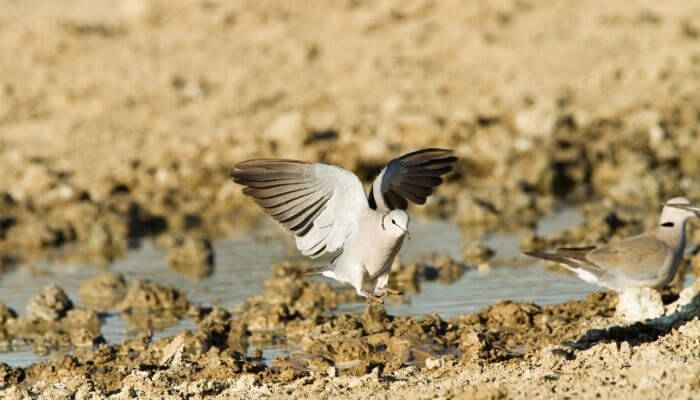No, doves do not cry.
Doves (pigeons) and dogs do use moisture to wet their eyes, and it is possible that they may over-wet their eyes so that a tear rolls down the cheek.
However, even though the physical act of tearing up is possible, the truth is that these creatures are not crying because of an emotional state.
Tears are running down their faces because their eyes are simply too watery.

Bigger Tear Ducts Means Bigger Tears
If many creatures are able to wet their eyes with tear ducts, why is it that only doves and dogs seem to over-wet and seemingly cry?
In truth, many types of animal can have eyes that are too watery, and many people in the Western hemisphere have dogs and so have probably seen them tear up (especially after coughing fits).
As for doves, how come we see more teary doves than we do the common blackbird, or parrot, or even budgie? The reason is that doves/pigeons have ever so slightly bigger tear ducts.
It is yet another quirk about pigeons that seems to exist on its own, such as how pigeons are one of the few birds that can suck through its beak to drink (rather than licking or gulping).
I Have Seen My Pigeons Tearing Up
If you see your pigeon looking glassy eyed, this is not because your pigeon is upset.
Many varieties of pigeons have very bright and glassy eyes.
In many cases, it is a sign your pigeon is healthy and happy.
Some doves have eyes that are as glassy as a guinea pig’s eyes, which may from a distance look as if they are tearing up.
Also Read: Do Pigeons Grieve?
My Bird Seems to Cry Overly Often
Though the bird is not bawling like a baby, some birds have a solitary tear run down their face simply because of the conditions in which they live.
Some pigeons have very dusty feathers, which creates a lot of in-air debris.
This is fine in the wild, but in a coop it causes problems.

As the birds flap their wings, they kick up a lot of this dust that gets into the bird’s eyes.
They do not have eyelashes and eyebrows to defend against this debris.
To combat the irritation of the dust, the tear ducts go into overdrive, and so very occasionally, you may see a tear running down your bird’s cheek.
Again, this is not an emotional response. It is a physical biological response to the bird’s environment.
What About Crying Noises?
You might imagine that the definitive conclusion that the tears produced by a dove/pigeon are not emotional is that no sounds accompany the tears.
For humans, it is impossible to cry silently.
At some point there needs to be a vocal or audible release along with the tears – even if it is only a sniff or a cough rather than crying sounds.
The mourning dove is so-called because of its distinctive call that sounds sad to humans.
This is a general call and cannot be termed as crying.
It also follows that the other calls of doves and pigeons that sound mournful, sorrowful or sad to humans do not indicate any of these emotions to other birds.
We should also remember that some birds (and indeed other creatures) have calls and sounds that may indicate a “feeling” to a human.
For example, a number of birds and animals have calls that are described as laughter. It is highly unlikely that any creature other than a human has the emotional capacity to laugh.
So when Prince sang “When doves cry” he was talking on a metaphysical level and that’s a whole other story…
